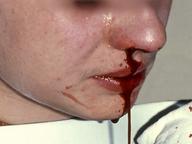Subject

photo credits: Wikimedia Commons
A nosebleed, also known as epistaxis, is an instance of bleeding from the nose. Blood can flow down into the stomach, and cause nausea and vomiting. In more severe cases, blood may come out of both nostrils. Rarely, bleeding may be so significant that low blood pressure occurs. Blood may also be forced to flow up and through the nasolacrimal duct and out of the eye, producing bloody tears. Risk factors include trauma, including putting the finger in the nose, blood thinners, high blood pressure, alcoholism, seasonal allergies, dry weather, and inhaled corticosteroids. There are two types: anterior, which is more common; and posterior, which is less common but more serious. Anterior nosebleeds generally occur from Kiesselbach's plexus while posterior bleeds generally occur from the sphenopalatine artery or Woodruff's plexus. The diagnosis is by direct observation. Prevention may include the use of petroleum jelly in the nose. Initially, treatment is generally the application of pressure for at least five minutes over the lower half of the nose. If this is not sufficient, nasal packing may be used. Tranexamic acid may also be helpful. If bleeding episodes continue, endoscopy is recommended. About 60% of people have a nosebleed at some point in their life. About 10% of nosebleeds are serious. Nosebleeds are rarely fatal, accounting for only 4 of the 2.4 million deaths in the U.S. in 1999. Nosebleeds most commonly affect those younger than 10 and older than 50. Source: Wikipedia (en)
Works about nosebleed
There is nothing here
Subject - wd:Q202013